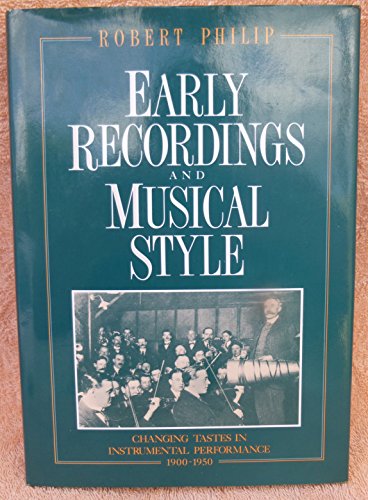Items related to Early Recordings and Musical Style: Changing Tastes...
Early Recordings and Musical Style: Changing Tastes in Instrumental Performance, 1900–1950 - Hardcover

Synopsis
Until recently, early recordings were regarded as little more than old-fashioned curiosities by musicians. Scholars and musicians now are beginning to realise their importance as historical documents which preserve the performance of composers and the musicians with whom they worked. In this fascinating study, Robert Philip argues that recordings of the early twentieth-century provide an important and hitherto neglected resource in the history of musical performance. The book concentrates on aspects of performance which underwent the greatest change in the early twentieth century, including rhythm, rubato, vibrato, and portamento. The final chapters explore some of the implications of these changes, both for the study of earlier periods and for the understanding of our own attitudes to the music of the past.
"synopsis" may belong to another edition of this title.
Book Description
In this fascinating study, Robert Philip argues that recordings of the early twentieth-century provide an important, and hitherto neglected, resource in the history of musical performance.
From the Back Cover
Until recently, early recordings were regarded as little more than old-fashioned curiosities. Scholars and musicians now are beginning to realise their importance as historical documents which preserve the performances of Elgar, Rachmaninoff, Stravinsky, and other composers, and of the musicians with whom they worked. In a more general way, recordings reveal the detailed performance practice of the early twentieth century and illustrate how styles have changed over the years. Early recordings also shed new light on nineteenth-century performance, but at the same time they highlight the limitations of our attempts to recreate the styles of the period before the development of recording. In this fascinating and detailed study, Robert Philip argues that recordings of the early twentieth century provide an important, and hitherto neglected, resource in the history of musical performance. The book concentrates on aspects of performance which underwent the greatest change in the early twentieth century: rhythm, including flexibility of tempo, rubato, and the treatment of rhythmic detail; the use of vibrato; and the employment of portamento by stringplayers. The final chapters explore some of the implications of these changes, both for the study of earlier periods and for the understanding of our own attitudes to the music of the past. The book contains information tables, music examples, and a discography and will be of interest to scholars and students of music history and performance practice as well as to musicians and collectors of historical recordings.
"About this title" may belong to another edition of this title.
FREE shipping within U.S.A.
Destination, rates & speedsSearch results for Early Recordings and Musical Style: Changing Tastes...
Early Recordings and Musical Style: Changing Tastes in Instrumental Performance, 1900â"1950
Seller: ThriftBooks-Atlanta, AUSTELL, GA, U.S.A.
Hardcover. Condition: Fair. No Jacket. Former library book; Readable copy. Pages may have considerable notes/highlighting. ~ ThriftBooks: Read More, Spend Less 2.45. Seller Inventory # G0521235286I5N10
Quantity: 1 available
EARLY RECORDINGS AND MUSICAL STYLE;
Seller: Counterpoint Records & Books, Los Angeles, CA, U.S.A.
Paper Covered Boards. Condition: Good. Dust Jacket Condition: Good. First Edition. Green paper covered boards, titles in white at spine, mild edge wear. Book body clean and tight. Green dust jacket, titles in yellow and white, mild edge wear, archival Brodart protected. Seller Inventory # 44628
Quantity: 1 available
Early Recordings and Musical Style: Changing Tastes in Instrumental Performance, 1900?1950
Seller: GoldBooks, Denver, CO, U.S.A.
Condition: new. Seller Inventory # 11L40_59_0521235286
Quantity: 1 available
Early Recordings and Musical Style: Changing Tastes in Instrumental Performance, 1900?1950
Seller: BennettBooksLtd, San Diego, NV, U.S.A.
hardcover. Condition: New. In shrink wrap. Looks like an interesting title! Seller Inventory # Q-0521235286
Quantity: 1 available
Early Recordings and Musical Style: Changing Tastes in Instrumental Performance, 1900-1950 Philip, Robert
Seller: online-buch-de, Dozwil, Switzerland
Jul 01, 1992. Condition: gebraucht; wie neu. minimale Spuren, wie ungelesen. Seller Inventory # 178-1-19
Quantity: 1 available

